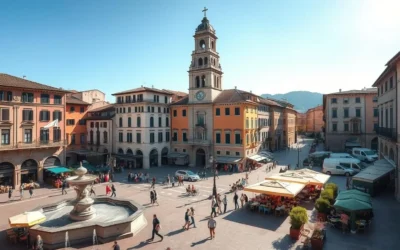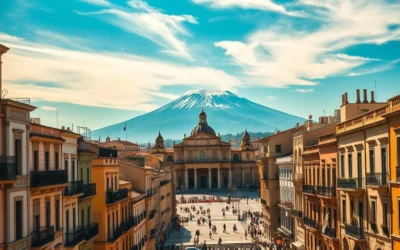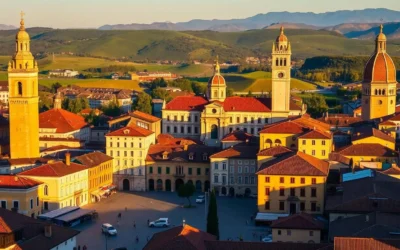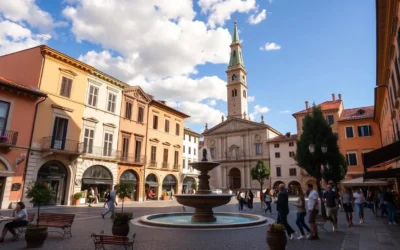✓ Accommodations✓ Flights✓ Rental Cars✓ Tours & Activities
Did you know that this iconic region welcomes over 94 million visitors annually? With its rolling hills, historic cities, and vibrant culture, it’s no wonder it’s a top destination. But to truly enjoy your visit, timing is everything.
The weather here varies greatly throughout the year. Summers can be scorching, while winters bring chilly rains. That’s why planning your trip around the season is crucial for a memorable experience.
For the most pleasant conditions, consider visiting during late spring or early fall. These months offer mild temperatures and fewer crowds, making it the perfect time to explore. Whether you’re strolling through vineyards or marveling at historic landmarks, the right weather can elevate your journey.
This guide will help you navigate the region’s seasonal changes, ensuring your trip is as enjoyable as possible. Let’s dive in!
Understanding Tuscany’s Seasonal Charm
Exploring this area means embracing its diverse climate and seasonal shifts. The Mediterranean weather here brings sunny days and clear skies, but it’s not without its surprises. Brief rain showers, especially in winter and early spring, add a touch of unpredictability to your trip.
Regional variations play a big role in shaping your experience. Coastal areas enjoy cooling breezes during the summer, while hill towns retain their warmth. Cities like Florence, on the other hand, can feel hotter due to their urban settings. These differences mean you’ll need to plan according to where you’re headed.
Mediterranean Climate and Regional Variations
Each part of this region has its own unique weather system. Coastal spots are perfect for those who love a refreshing sea breeze. Inland cities, however, can get quite warm during the summer months. Hill towns offer a balance, staying pleasantly warm without the intense heat.
For example, Florence’s city center can feel much hotter than the nearby coastal areas. This contrast highlights the importance of choosing your destinations wisely. Whether you’re strolling through a city or relaxing by the sea, understanding these variations ensures a more enjoyable trip.
When Nature Shapes Your Trip
Seasonal changes influence the atmosphere in both cities and countryside. Spring brings mild temperatures and blooming landscapes, making it ideal for outdoor activities. Summer, while hot, offers long days perfect for exploring, though midday heat can be intense.
Fall is another great time to visit, with pleasant weather and fewer crowds. Winter, though cooler, has its own charm with festive markets and cozy vibes. By aligning your activities with the season, you can make the most of your time here.
Understanding these patterns allows you to tailor your trip to your preferences. Whether you’re chasing sunny days or prefer milder weather, the right timing can elevate your experience.
Tuscany, Italy: Best Months for a Weather-Savvy Trip
Timing your trip to align with ideal weather conditions ensures a more enjoyable journey. Whether you’re exploring historic sites, dining outdoors, or attending local events, the right weather can elevate your experience. Each season offers unique opportunities, so planning ahead is key.
Optimal Weather for Every Activity
Spring and fall are perfect for sightseeing, with mild temperatures and blooming landscapes. Summer is ideal for beach trips, though midday heat can be intense. Winter, while cooler, offers quieter attractions and even snowy peaks in the mountain areas.
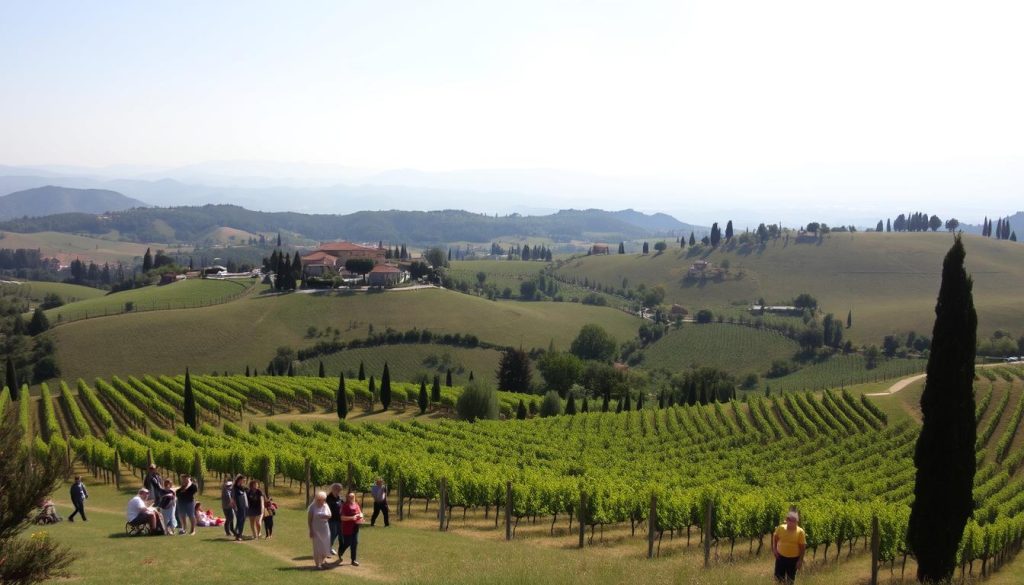
Rain plays a role in shaping your plans, especially in winter and early spring. However, even during these months, there are plenty of clear days to explore. Understanding local weather patterns helps you make the most of your time.
Balancing Crowds and Local Events
Choosing the right month can help you balance the beauty of this destination with manageable crowd levels. Shoulder seasons like spring and fall are less crowded, making it easier to enjoy popular spots. Winter offers a serene atmosphere, perfect for those seeking tranquility.
Local events add another layer of charm to your visit. From festive markets in winter to harvest celebrations in fall, there’s always something happening. Aligning your trip with these events can make your experience even more memorable.
| Season | Weather | Activities |
|---|---|---|
| Spring | Mild, occasional rain | Sightseeing, outdoor dining |
| Summer | Hot, sunny | Beach trips, festivals |
| Fall | Pleasant, fewer crowds | Harvest events, hiking |
| Winter | Cool, occasional rain | Winter sports, festive markets |
Planning Your Weather-Savvy Itinerary
Planning your journey around the right weather conditions can make all the difference. By aligning your schedule with the best time visit, you’ll avoid extremes and enjoy every moment. This approach ensures a smoother, more enjoyable trip.
Customized Schedules for Ideal Weather
Start by researching the region’s climate patterns. Coastal areas often have cooler breezes, while inland cities can get warmer. Use this knowledge to plan your daily activities. For example, explore cities in the morning when temperatures are milder, and save afternoons for shaded or indoor attractions.
Seasonal changes also play a role. Spring and fall offer mild weather, perfect for outdoor adventures. Summer is great for beaches, but midday heat can be intense. Winter, though cooler, is ideal for cozy indoor experiences and festive markets.
Tips for Booking Ahead & Timed-Entry Attractions
Popular destinations like Florence, Siena, and Lucca often require timed-entry tickets. Booking ahead ensures you don’t miss out on must-see spots. Check local weather forecasts to avoid rainy days for outdoor activities.
Here are some practical tips:
- Use regional weather trends to plan your trip around the best time visit.
- Book timed-entry attractions early, especially in peak seasons.
- Customize your schedule to avoid midday heat or unexpected rain.
By tailoring your plans to the region’s climate, you’ll enjoy a seamless and memorable journey. Whether you’re exploring historic sites or relaxing by the coast, a weather-savvy itinerary enhances every experience.
Seasonal Weather Breakdown in Tuscany
Each season in this region brings its own unique charm and challenges, making it essential to plan your visit wisely. Whether you’re drawn to blooming landscapes or cozy nights by the fire, understanding the weather patterns ensures a memorable trip.
Spring and Early Fall: Mild and Blooming
Spring and early fall are celebrated for their mild temperatures and stunning landscapes. These seasons are perfect for exploring the area without the intense heat or large crowds. Blooming flowers and lush greenery create a picturesque backdrop for outdoor activities.
During these months, temperatures range from 15°C to 25°C (59°F to 77°F), making it ideal for hiking, sightseeing, and outdoor dining. Fewer tourists mean you can enjoy popular spots without the hustle and bustle.
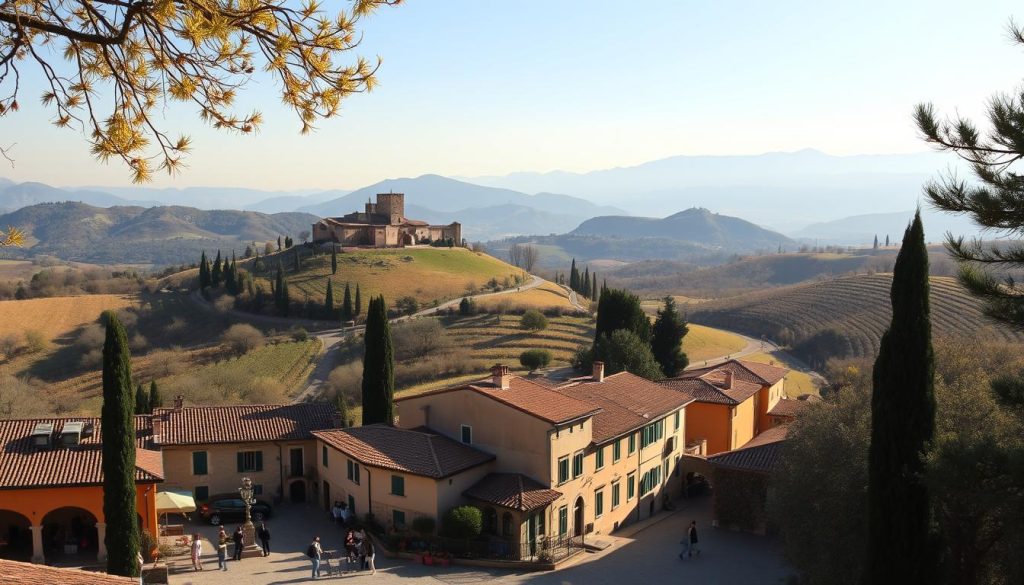
Summer and Winter: Heat Waves and Cozy Cold
Summer brings heat waves, with temperatures often reaching up to 35°C (95°F). While the beach becomes a popular escape, expect larger crowds and vibrant cultural events. Early mornings and late evenings are the best times to explore during this season.
Winter, on the other hand, offers a cozy atmosphere with cooler temperatures averaging around 5°C (41°F). Rain is common, but it’s also a great time to experience local festivals and enjoy quieter attractions.
“Winter nights are perfect for savoring warm meals and local wines by the fire.”
| Season | Weather | Highlights |
|---|---|---|
| Spring | Mild, blooming | Fewer crowds, outdoor activities |
| Summer | Hot, sunny | Beach trips, cultural events |
| Fall | Pleasant, colorful | Harvest festivals, scenic walks |
| Winter | Cool, rainy | Local festivals, cozy nights |
Choosing the right season depends on your preferences. Whether you’re chasing sunny days or prefer a quieter experience, each season offers something special. Plan ahead to make the most of your trip!
Best Time for Outdoor Adventures and Beach Trips
Outdoor adventures and beach trips are at their best when timed perfectly with the weather. The region’s climate plays a big role in shaping your experience, so planning ahead ensures you make the most of your visit. Whether you’re hiking scenic trails or relaxing by the coast, the right timing can elevate your journey.
Exploring Scenic Trails
Spring and fall are ideal for hiking and cycling, offering mild temperatures and stunning landscapes. These shoulder seasons provide fewer tourist crowds, making it easier to enjoy nature. Trails like the Via Francigena or the Apuan Alps offer breathtaking views and a chance to connect with the outdoors.
During these months, temperatures range from 15°C to 25°C (59°F to 77°F), creating perfect conditions for outdoor activities. The blooming flowers and lush greenery add to the charm, making every hike a memorable experience.
Enjoying Coastal and Beach Experiences
Beach resorts are particularly popular in July and August, but the shoulder months of April, May, September, and October offer a more relaxed atmosphere. These periods provide pleasant sunny days without the overwhelming summer crowds.
Coastal areas like the Maremma or Versilia are perfect for beach lovers. You can enjoy the sea breeze, explore hidden coves, or simply relax on the sand. Visiting during fall also means you’ll avoid the peak season rush, allowing for a more peaceful experience.
| Activity | Best Time | Highlights |
|---|---|---|
| Hiking | Spring, Fall | Mild weather, fewer crowds |
| Beach Trips | Late Spring, Early Fall | Sunny days, relaxed atmosphere |
| Cycling | Spring, Fall | Scenic trails, pleasant temperatures |
By choosing the right time for your outdoor adventures and beach trips, you’ll enjoy a more fulfilling and enjoyable experience. Whether you’re exploring trails or lounging by the sea, the region’s natural beauty awaits.
Experiencing Local Festivals and Harvest Events
Immerse yourself in the vibrant culture of this region by timing your visit with its lively festivals and harvest events. These celebrations offer a unique glimpse into local traditions, blending food, wine, and agricultural heritage. Whether you’re exploring a bustling town or a quiet village, these events bring the community together in unforgettable ways.

Cultural Delights and Food Celebrations
From grape harvests in September to truffle fairs in October, the region’s calendar is packed with events that celebrate its rich culinary traditions. The grape harvest, or vendemmia, is a highlight, offering a chance to participate in wine-making and enjoy tastings. Truffle festivals, like those in Acqualagna and Pietralunga, showcase the prized ingredient in dishes and markets.
These events are more than just about food—they’re a celebration of the land and its people. You’ll find live music, cooking demonstrations, and opportunities to connect with locals. The warmth of the heat during these gatherings adds to the festive atmosphere, making them a must-experience.
Unique City Events and Must-See Traditions
Even smaller towns have their own unique celebrations. Montalcino’s Sagra del Tordo, for example, features an archery tournament and traditional feasts. In Certaldo Alto, the Boccaccesca gastronomic fair highlights local flavors with wine tastings and artisanal products.
These events provide a deeper understanding of the region’s heritage. They’re a chance to see how harvest traditions have shaped the culture over centuries. By attending, you’ll gain a richer appreciation for the area’s history and way of life.
Plan your trip around these events for an immersive experience. Whether you’re savoring a glass of wine during the grape harvest or exploring a truffle market, these celebrations will leave a lasting impression.
How to Pack for Tuscany’s Changing Weather
Packing for a trip with unpredictable weather can be a challenge, but with the right strategy, you’ll stay comfortable no matter what. The key is versatility—preparing for warm days, cooler evenings, and unexpected rain. By packing smartly, you can enjoy your journey without worrying about sudden weather shifts.
Layering Techniques for Variable Climates
Layering is your best friend when dealing with changing temperatures. Start with lightweight pieces for mild days, like breathable shirts and pants. Add a mid-layer, such as a sweater or cardigan, for cooler evenings. Finally, include a durable jacket for chilly nights or unexpected rain.
This approach works well from late spring to the end of autumn. It allows you to adjust your outfit as the day progresses. For example, you can remove layers during warmer afternoons and add them back as the evening cools down.
Essential Accessories for Sun, Rain, and Chill
Accessories can make a big difference in staying comfortable. A wide-brimmed hat and sunglasses are essential for sunny days. For rain, pack a compact umbrella or a waterproof jacket. Shawls or scarves are great for modesty and added warmth during cooler evenings.
Don’t forget sturdy shoes for walking and exploring. Comfortable footwear is crucial, especially if you’re planning to hike or stroll through cobblestone streets. These items ensure you’re prepared for any weather, from the warmth of late spring to the chill of autumn’s end.
| Item | Purpose |
|---|---|
| Lightweight Layers | Adapt to mild temperatures |
| Durable Jacket | Protect against rain and chill |
| Wide-Brimmed Hat | Shield from sun |
| Compact Umbrella | Handle unexpected showers |
| Sturdy Shoes | Ensure comfort for walking |
By packing these essentials, you’ll be ready for whatever the weather brings. Whether it’s a sunny afternoon or a cool evening, you’ll stay comfortable and enjoy every moment of your trip.
Travel Tips for Navigating Crowds and Attractions
Avoiding crowds at major attractions is easier than you think. With a bit of planning, you can enjoy iconic landmarks without the stress of long lines or packed spaces. Here’s how to make the most of your time while staying relaxed.
Smart Planning to Avoid Peak Hours
One of the best ways to experience popular spots is by visiting during less crowded times. Early mornings or late evenings are ideal for exploring. Most tourists arrive between 10 AM and 4 PM, so adjusting your schedule can help you avoid the rush.
For attractions situated on a hill, like some historic sites, plan your visit for cooler parts of the day. This not only helps you beat the heat but also ensures a more peaceful experience. Booking timed-entry tickets in advance is another great way to save time and skip the lines.
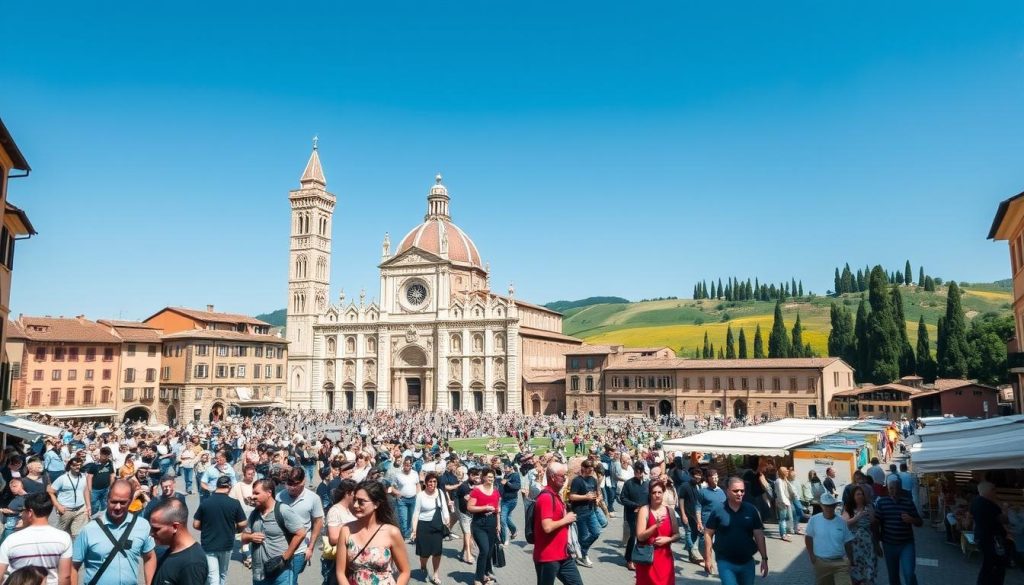
- Visit key sites early in the morning or in the evening to enjoy a less crowded atmosphere.
- Plan your day to include attractions on a hill during cooler hours.
- Layer your visit with alternative activities, like a leisurely lunch or a stroll through quieter areas, when attractions are busiest.
By following these strategies, you’ll maximize your time and enjoy a more relaxed trip. Whether you’re exploring historic landmarks or scenic spots, smart planning ensures a memorable experience.
Booking Smart: Budgeting Your Italian Adventure
Planning your trip with a budget in mind doesn’t mean sacrificing quality or experiences. With a few smart strategies, you can enjoy your time visit tuscany without breaking the bank. From flights to accommodations, every part of your journey can be optimized for savings.
Finding Deals with Off-Season Advantages
Traveling during off-peak months is one of the best ways to save. Flights and accommodations are often cheaper, and you’ll encounter fewer tourists. This makes it an ideal time visit tuscany for a more relaxed experience.
For example, visiting in late fall or early spring can offer significant discounts. You’ll still enjoy pleasant weather, but with the added benefit of lower costs. This approach allows you to stretch your budget further while exploring every part of the region.
Strategies for Affordable Flights and Accommodation
Booking early is key to securing the best deals. Airlines and hotels often offer lower rates for those who plan ahead. Flexibility with your travel dates can also lead to substantial savings.
Here are some tips to keep in mind:
- Use price comparison tools to find the best rates for flights and hotels.
- Consider alternative accommodations like vacation rentals, which can be more budget-friendly.
- Look for discounts on regional trains instead of high-speed options.
By following these strategies, you can make the most of your visit tuscany without overspending. Whether you’re a first-time visitor or a seasoned traveler, these tips ensure a memorable and affordable trip.
“Traveling off-season not only saves money but also offers a more authentic experience with fewer crowds.”
Flexible planning is essential for balancing your budget and experience. By considering all your options, you can enjoy every part of your journey while staying within your means. Whether it’s your first visit tuscany or a return trip, smart budgeting ensures a stress-free adventure.
Conclusion
Making the most of your journey involves aligning your plans with the region’s unique seasonal charm. Understanding the weather patterns ensures you enjoy outdoor activities, explore iconic landmarks, and attend vibrant festivals without hassle. Whether you’re relaxing at a beach resort or immersing yourself in local culture, timing is key.
Planning ahead allows you to avoid crowds and make the most of your travel experience. From booking accommodations to packing for variable weather, every detail matters. Attending seasonal events adds depth to your trip, offering a glimpse into the area’s traditions and lifestyle.
Use this guide to create a seamless itinerary that balances pleasant weather and enriching experiences. With thoughtful preparation, your adventure will be as memorable as it is enjoyable.
The above is subject to change.
Check back often to TRAVEL.COM for the latest travel tips and deals.


